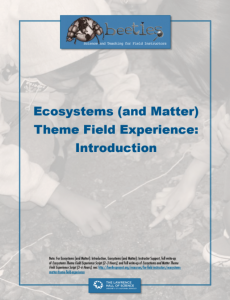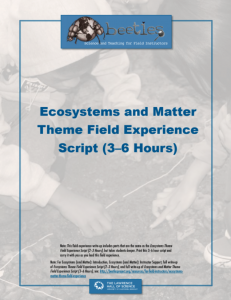It’s awesome when an activity leaves students excited about a science topic, interesting ideas, and some aspect of nature. It can be even more rewarding to lead a series of activities, starting out by getting a sense of where students are at to begin, taking them on a journey of learning, and tying everything together throughout a themed field experience. A thoughtfully sequenced series of activities can help students build understanding of key science concepts, and having a theme that weaves through the activities can make the field experience more coherent. The more coherent the experience, the more likely it is that students will walk away with meaningful and memorable learning.
Why lead a theme field experience on ecosystems?
A fundamental part of outdoor science and environmental education is learning about the living parts of nature (including humans) as well as the nonliving parts of nature and how those parts interact. Studying an ecosystem means looking at how living and nonliving things interact within a particular environment. Every individual organism in an ecosystem is incredibly complex and impossible to ever fully understand, and a whole ecosystem is so much more complex than that. We can learn a lot, though, about organisms and ecosystems through our own observations and through engaging with sources of information such as books and field guides. The more we do understand, the more we’re equipped to make thoughtful decisions about policies and actions within our personal lives that impact Earth, other organisms, and humans.
It’s also fun and interesting to learn about an ecosystem! As we each develop our ecosystem literacy, we become more comfortable being in nature and more curious about it. To understand an ecosystem, you’ve got to explore it, and students tend to love engaging directly with nature by making observations and getting up close and personal with organisms. As students try to figure out what lives in the ecosystem, observe interactions between its parts, and think together about how those parts affect one another, they are also developing critical science and life skills, such as making observations, making explanations from evidence, working together as a team, and thinking from a systems point of view.
Notes for Classroom Educators
This document was written and published for use as a single extended (2-3 hours or 4-6 hours) field experience for use in informal programs. It can be easily adapted to be a series of shorter (~45-60 minutes) field experiences that can be led anywhere outdoors with nature (eg: schoolyards).
- If teaching in a formal K12 setting, use the 4-6 hour experience to work from. This script includes more options for extending and deepening the experience, if desired. See the planning chart on pages 9-10 for suggestions on scheduling.
- The document often refers to the sequence as a single extended field experience. Don’t worry, you can adapt it to teach as a series of field experiences. The individual BEETLES activities referenced in the sequence are each between ~45-60 minutes long. The shorter introductory activities at the beginning of the sequence can all fit into a ~45-60 minutes long session.
- The write-up often refers to moving locations between activities using a moving version of Thought Swap. This may not apply to those who are teaching it as a sequence of sessions in a schoolyard, in which case you can simply use the moving version of Thought Swap when moving to or from the location, or else use the stationary version of Thought Swap if you are not moving to another location.
- Name game: You Are What You Eat. If your students already know each other’s names, this is still a valuable (and fun) activity to begin with.




